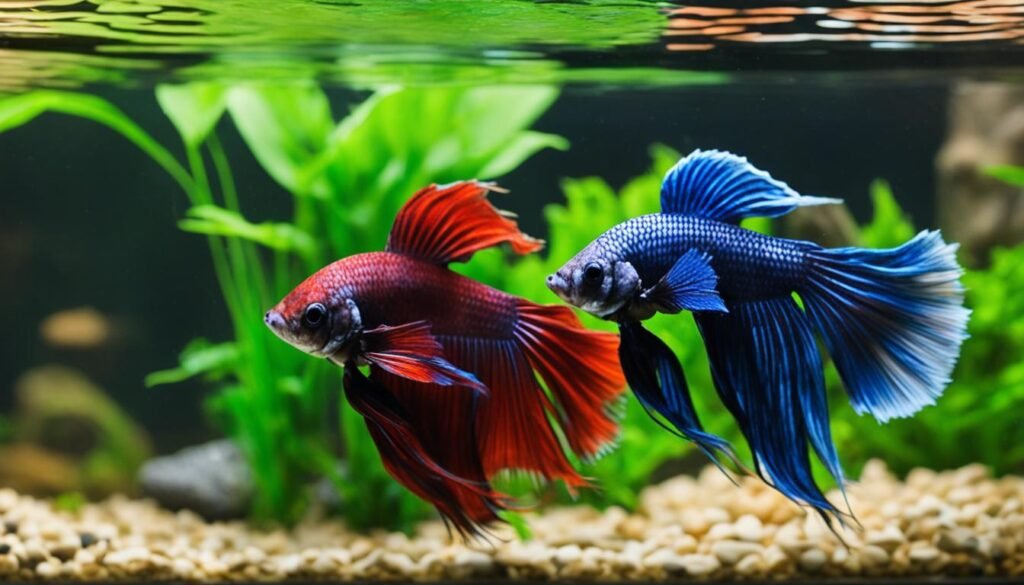Can you put a male and female Betta fish together? Are they compatible tank mates? These questions often arise among aquarium enthusiasts. Male and female Betta fish, also known as Siamese fighting fish, are popular for their vibrant colors and unique personalities. While they are typically kept alone due to their aggression, some aquarium owners wonder if it’s possible to house them together.
Can Male and Female Betta Fish Live Together?
Male and female Betta fish have unique characteristics that make it challenging for them to coexist peacefully in the same tank. These fish are known for their aggressive and territorial nature, which often leads to fights and potential harm to one another.
When placed together, male Betta fish will typically fight for dominance, displaying aggressive behavior that can be quite violent. These fights can result in severe injury or even the death of one or both fish.
While it is technically possible to keep male and female Betta fish together, it is not recommended due to the potential risks involved. However, if you still wish to attempt cohabitation, certain precautions must be taken.
A larger tank with plenty of hiding places is crucial to provide both fish with their own territories. This helps reduce their aggression towards each other and increases their chances of survival. Careful monitoring of their behavior is essential, and it is crucial to separate them immediately if any signs of aggression or stress arise.
Remember, the well-being of both the male and female Betta fish should be the top priority. It is recommended, though, to house them separately to ensure their safety and overall health.
Can Male and Female Betta Fish Live Together? The Pros and Cons
Let’s take a closer look at the pros and cons of keeping male and female Betta fish together in a more structured format:
| Pros | Cons |
|---|---|
| Opportunity for breeding | Risk of injury or death due to aggression |
| Vibrant and beautiful display | Greater need for a larger tank and hiding places |
| Natural behaviors and courtship rituals | Requires careful monitoring and immediate separation if necessary |
| Possible socialization and interaction between the fish | Potential stress and decreased well-being for both fish |
As the table highlights, while there are certain potential benefits to keeping male and female Betta fish together, the risks and challenges involved often outweigh the rewards.
By carefully considering the nature of these fish and providing them with suitable conditions and separate tanks, you can ensure their health, happiness, and longevity.
Short-Term and Long-Term Arrangements
When it comes to keeping male and female Betta fish together, there are two main types of arrangements: short-term and long-term. Each option has its own considerations and potential risks.
Short-Term Arrangements
In certain situations, such as when cleaning the tank, it may be necessary to temporarily house male and female Betta fish together. This short-term arrangement can last for a few hours, but it is crucial to closely monitor their behavior during this time.
Signs of aggression, such as flaring, chasing, or attacking, should not be taken lightly. If any aggressive behaviors are observed, it is best to separate the fish immediately to prevent harm.
It’s important to note that short-term arrangements should only be done when absolutely necessary, as the risk of aggression and injury is higher when male and female Betta fish are together.
Long-Term Arrangements
In long-term arrangements, keeping male and female Betta fish together requires a larger tank with plenty of accessories and hiding spots. This setup is designed to minimize aggression and provide a more suitable environment for both fish.
While a carefully managed long-term arrangement can work, it is essential to understand that aggression can still occur, even with the most ideal conditions. The territorial nature of Betta fish means that conflicts may arise despite our best efforts.
Considering the potential risks and the importance of ensuring the well-being of the fish, it is generally recommended to separate male and female Betta fish into their own tanks for long-term housing.
Problems with Keeping Male and Female Betta Fish Together
When it comes to housing male and female Betta fish together, several problems can arise due to their natural behaviors and instincts. Understanding these issues is crucial for ensuring the well-being and safety of both fish.
1. Aggression towards each other
Male Betta fish are known for their territorial nature and can be aggressive towards other fish, including females. They will fiercely defend their territory and may attack any fish that comes near, resulting in injuries or even death. This aggressive behavior is a significant challenge when attempting to house male and female Betta fish together.
2. Potential aggression between females during mating season
While female Betta fish can generally coexist peacefully in a “sorority” tank, conflicts can still arise during mating season. When vying for the attention of a male Betta, females may display aggression towards each other, leading to fights and injuries. This can disrupt the harmony of the tank and put the fish at risk.
3. Stress and improper egg laying
Keeping female Betta fish with males can cause stress and hinder their ability to lay eggs properly. The presence of a male can induce stress in females, leading to decreased reproductive success. To ensure successful breeding and the well-being of the female Betta fish, it is best to keep males and females in separate tanks.
Summary
While it may be tempting to house male and female Betta fish together, it is important to understand the potential problems that can arise. The aggressive nature of male Betta fish, the potential aggression between females, and the stress it can cause females during breeding all make it challenging and risky to keep them together. To provide a safe and healthy environment for your Betta fish, it is recommended to house them separately.
| Problem | Description |
|---|---|
| Aggression | Male Betta fish are territorial and aggressive towards other fish, including females, leading to fights and possible injuries. |
| Potential aggression between females | During mating season, female Betta fish may display aggression towards each other when vying for the attention of a male Betta. |
| Stress and improper egg laying | Keeping female Betta fish with males can induce stress and hinder their ability to lay eggs properly, impacting successful breeding. |
Conclusion
When it comes to male and female Betta fish, their compatibility and cohabitation can pose challenges due to their aggressive and territorial nature. Male Betta fish are known for their aggression towards other fish, including females, which can lead to injuries or even fatalities.
While it is possible to keep male and female Betta fish together, it requires careful consideration and a suitable environment. A larger tank with plenty of hiding places is essential to minimize aggression and provide space for both fish. However, even with these precautions, the risk of fights and harm remains.
If breeding is the goal, introducing and timing the mating process becomes crucial. It is recommended to strictly follow the necessary steps under expert guidance to ensure the safety and well-being of both male and female Betta fish.
Overall, while the idea of keeping male and female Betta fish together may be appealing, it is safer and easier to keep them separate. By maintaining separate tanks, you can ensure the health and happiness of your Betta fish without the risk of aggression and harm.


